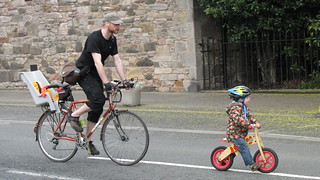Motorcyclists are very strongly directed to 'Learn the Lifesaver' the check back over the right shoulder.
Aside from T bone crashes the majority of serious cycle crashes involve either being struck from the rear or close passed, often with a left turn.
So in many cases, that awareness will play a key role in giving a cyclist advance warning of a motor vehicle being driven into their current road space, and give the opportunity to get out of the way or make their presence more obvious, the choice being appropriate to the circumstances.
Ian Walker left us hanging with that conundrum after the OxCam report (2005?), but the fact that almost every HGV-cycle fatality in London is a (generally young) woman seems to fit that result.
I do have a possible factor - many women are riding bikes built and sized for men, and as such the frames and handlebar reach are designed for body proportions where the arms-torso ratio is for longer arms relative to torso than the typical female ratio. There is also the basic ratio that a classic female body has hips and shoulders around the same width, but the male body has hips and rib cage the same width and wider shoulders. This is, I observe, changing, and (forgive me if it looks like I'm staring) I'm noticing women with wider shoulder development. It often transpires that they are sports swimmers or triathletes, although I sense a trend.
Many women sort out the shoulder pains and other issues of riding a bike built for a man by fitting handlebars with a shorter reach, and putting the saddle further forward.
If however you are riding a bike which as your arms at full stretch, rather than slightly bent, any turn of the head, which naturally delivers a slight turn of the shoulders, will cause the handlebars to move (because the arms are straight)
Alternatively it has to be the Lot's Wife syndrome... long held fear for consequences of looking back

 posts
posts
